Image quality of aspheric IOLs
Explanations
The measurement results of aspheric intraocular lenses (IOL) are listed below. All measurements are carried out using the measuring stand developed at the Institute in accordance with EN/ISO 11979-2 [ISO11979]. In accordance with ISO, the IOL to be tested is operated under in-vivo conditions within an artificial eye in a water bath that simulates the rest of the eye (cornea and aqueous humor).
Each lens is generally measured in two refractive powers (usually +13dpt. and +26dpt, or the closest value provided by the manufacturer) in order to visualize the effects of spherical aberrations. A graph of the measured MTF and the value of the Strehl ratio (comparison between measured IOL and diffraction-limited ideal IOL) as well as the ISO criterion (modulation at 100 line pairs/mm) are listed for each measured lens. Explanations of the following graphs can be found under quality criteria.
Aberration-corrected IOLs are generally aspheric IOLs whose design assumes a slightly aspheric cornea rather than a purely spherical cornea, as is usually the case. The reason for this is that studies have shown that the human cornea exhibits this slight asphericity on a statistical average and therefore IOLs that take this asphericity into account lead to better visual acuity [Brennan97] [Holladay02 ] [Piers04].
For measurements according to ISO11979, however, a purely spherical artificial cornea is specified. Accordingly, aberration-corrected aspheric lenses (e.g. **Acri.Smart 36A, Tecnis Z9000) tend to perform somewhat worse in these measurements than non- aberration-corrected aspheric lenses (e.g. Ultra Choice PHC001). However, this is not representative for the in vivo use of aberration-corrected IOLs, as the measurement setup according to ISO11979 does not take this statistical asphericity of the human cornea into account.
Measurements with a modified measurement system using a corresponding aspheric artificial cornea will therefore be submitted at a later date.
It should also be mentioned that a Strehl ratio greater than 0.90 is generally far superior to the other optical components of the human eye and therefore only rarely helps the patient to achieve a subjective improvement in visual acuity. (Read more about the different IOL designs here).
List of IOLs examined
| IOL manufacturer | IOL type | Type | Measured refractive power |
| *Acri.Tec | *Acri.Smart 36A | aspheric, aberration corrected | +13dpt., +26dpt. |
| Pharmacia | Tecnis Z9000 | aspherical, aberration corrected | +13dpt., +26dpt. |
| Sifi | Mini 4 | aspherical | +13dpt., +26dpt. |
| ThinOptiX | Ultra Choice PHC001 | aspherical | +15dpt., +25dpt. |
Detailed measurement results
*Acri.Tec - *Acri.Smart 36A (aspherical, aberration corrected*)
| +13dpt. | +26dpt. |
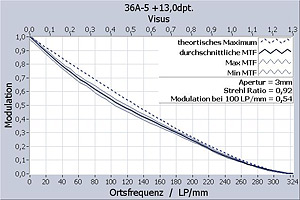 |
 |
| Strehl ratio: 0.92 ISO criterion: 0.54 (ISO%: 85.4%) |
Strehl ratio: 0.91 ISO criterion: 0.62 (ISO%: 90.5%) |
Pharmacia - Tecnis Z9000 (aspherical, aberration corrected*)
| +13dpt. | +26dpt. |
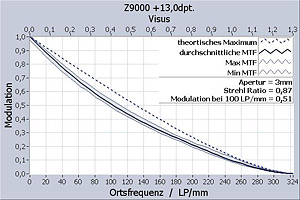 |
 |
| Strehl ratio: 0.87 ISO criterion: 0.51 (ISO%: 80.7%) |
Strehl ratio: 0.85 ISO criterion: 0.55 (ISO%: 80.3%) |
Sifi - Mini 4
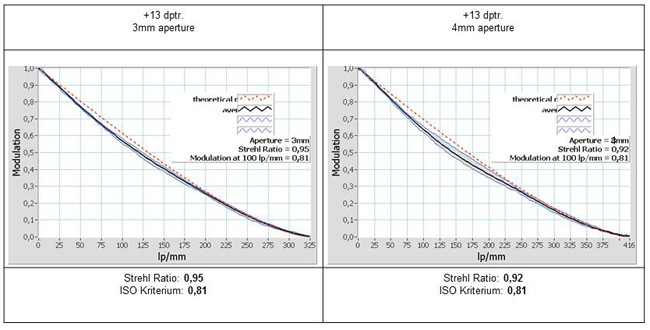
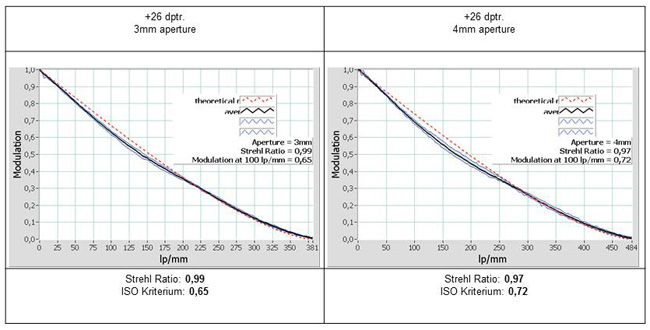
ThinOptiX - UltraChoice PHC001 (aspherical)
| +15dpt. | +25dpt. |
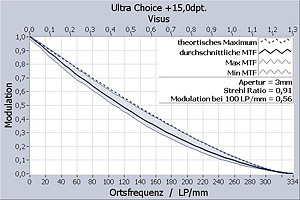 |
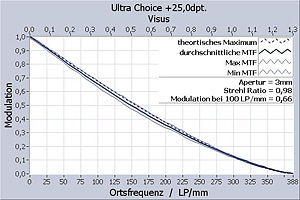 |
| Strehl ratio: 0.91 ISO criterion: 0.56 (ISO%: 90.3%) |
Strehl ratio: 0.98 ISO criterion: 0.66 (ISO%: 97.1%) |
Contact
Prof. Dr. rer.nat. Wilhelm Stork
Tel. 0721 / 608 - 42510, wilhelm.stork∂kit.edu

